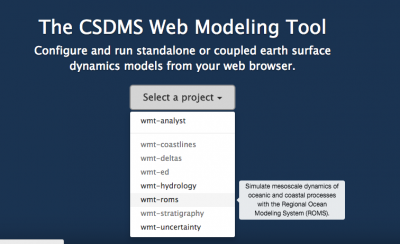Labs WMT ROMSLIte RiverPlume: Difference between revisions
No edit summary |
(added selection panel for ROMS) |
||
| Line 2: | Line 2: | ||
'''Authors'''<br> | '''Authors'''<br> | ||
This lab has been designed and developed by Courtney Harris | This lab has been designed and developed by Courtney Harris and Julia Moriarty, Virginia Institute of Marine Sciences, Gloucester Point, VA <br> | ||
with assistance of Irina Overeem, CSDMS, University of Colorado, CO | with assistance of Irina Overeem, CSDMS, University of Colorado, CO | ||
'''Classroom organization'''<br> | '''Classroom organization'''<br> | ||
This lab is the first in a series of introduction to the Regional Ocean Modeling System (ROMS) for inexperienced users. ROMS is a three-dimensional hydrodynamic ocean model. It solves the conservation of mass and 3D momentum equations and includes transport equations for temperature and salinity. Here we present a basic configuration of ROMS in the framework of the Web Modeling Tool (WMT), it is designed for inexperienced modelers to look at a river plume affecting the coastal ocean and sediment transport. This lab will likely take ~ 3hours to complete in the classroom. <br> | |||
If you have never used the Web Modeling Tool, learn how to use it [[WMT_tutorial|here]]. The WMT allows you to set up simulations, but once you are ready to run them, you will need an account on the CSDMS supercomputer to submit your job. | If you have never used the Web Modeling Tool, learn how to use it [[WMT_tutorial|here]]. The WMT allows you to set up simulations, but once you are ready to run them, you will need an account on the CSDMS supercomputer to submit your job. | ||
More information on getting an account can be found here [[HPCC_Access| HPCC Access]]<br> | More information on getting an account can be found here [[HPCC_Access| HPCC Access]]. Note that getting permission for access takes a few days after your application<br> | ||
'''Learning objectives'''<br> | |||
Skills | |||
* familiarize with a basic configuration of the Regional Ocean Modeling System | |||
* hands-on experience with visualizing NetCDF output with Matlab or Panoply. | |||
Topical learning objectives: | |||
* integration of the conservation of momentum, continuity equation and conservation of tracers into a specific advection-diffusion scheme | |||
* learn about a river freshwater plume evolving into a marine basin | |||
'''Lab Notes'''<br> | |||
>> Open a new browser window and open the Web Modeling Tool [https://csdms.colorado.edu/wmt-ROMSLite WMT with hydrology components]<br> | |||
<br> | |||
[[File:Select_ROMSLite_.png | 400px]] | |||
<br> | |||
We set up a basic numerical experiment with inputs considered representative for a medium-sized river draining into the coastal ocean. The incoming river carries freshwater and suspended sediment into the salty ocean water. The river discharge is kept constant over the duration of the simulation at 1500 m3/sec. | |||
The model domain is 102 by 142 gridcells, gridcells are dx=500m and dy= 750m, so you are looking for this experiment ROMS has 20 vertical layers in the water column, and stores 10 layers in the ocean bed. Initial layer is 20 cm. | |||
Revision as of 09:49, 13 May 2016
Introduction to Regional Ocean Modeling - River Plumes
Authors
This lab has been designed and developed by Courtney Harris and Julia Moriarty, Virginia Institute of Marine Sciences, Gloucester Point, VA
with assistance of Irina Overeem, CSDMS, University of Colorado, CO
Classroom organization
This lab is the first in a series of introduction to the Regional Ocean Modeling System (ROMS) for inexperienced users. ROMS is a three-dimensional hydrodynamic ocean model. It solves the conservation of mass and 3D momentum equations and includes transport equations for temperature and salinity. Here we present a basic configuration of ROMS in the framework of the Web Modeling Tool (WMT), it is designed for inexperienced modelers to look at a river plume affecting the coastal ocean and sediment transport. This lab will likely take ~ 3hours to complete in the classroom.
If you have never used the Web Modeling Tool, learn how to use it here. The WMT allows you to set up simulations, but once you are ready to run them, you will need an account on the CSDMS supercomputer to submit your job.
More information on getting an account can be found here HPCC Access. Note that getting permission for access takes a few days after your application
Learning objectives
Skills
- familiarize with a basic configuration of the Regional Ocean Modeling System
- hands-on experience with visualizing NetCDF output with Matlab or Panoply.
Topical learning objectives:
* integration of the conservation of momentum, continuity equation and conservation of tracers into a specific advection-diffusion scheme
- learn about a river freshwater plume evolving into a marine basin
Lab Notes
>> Open a new browser window and open the Web Modeling Tool WMT with hydrology components

We set up a basic numerical experiment with inputs considered representative for a medium-sized river draining into the coastal ocean. The incoming river carries freshwater and suspended sediment into the salty ocean water. The river discharge is kept constant over the duration of the simulation at 1500 m3/sec. The model domain is 102 by 142 gridcells, gridcells are dx=500m and dy= 750m, so you are looking for this experiment ROMS has 20 vertical layers in the water column, and stores 10 layers in the ocean bed. Initial layer is 20 cm.
